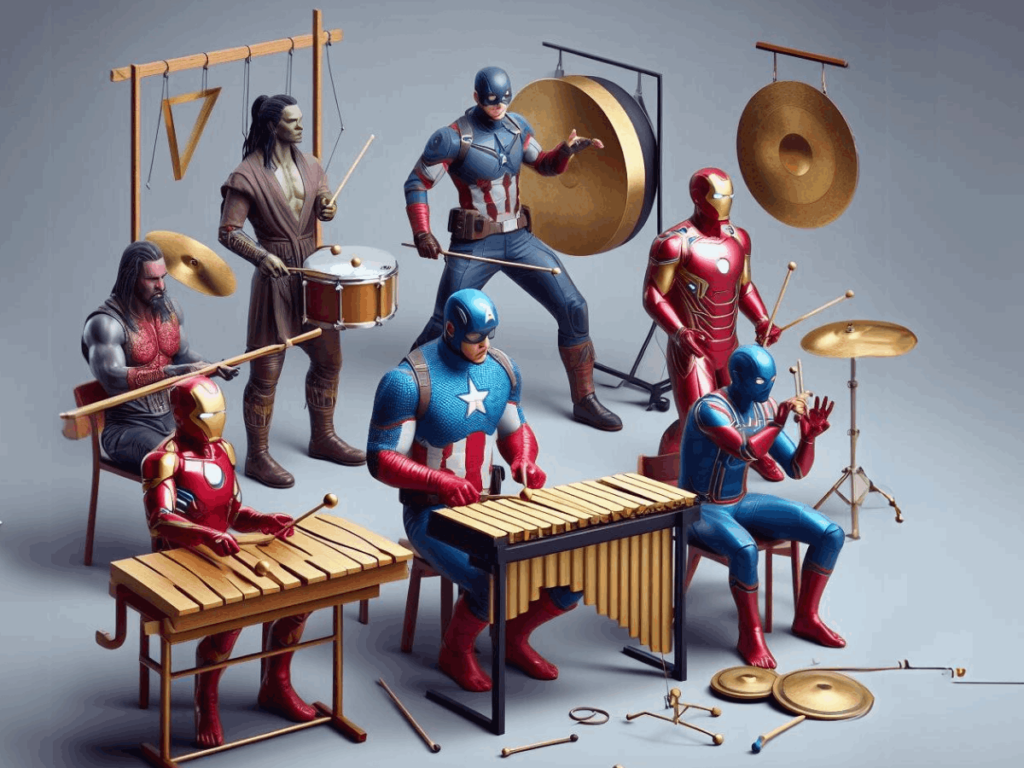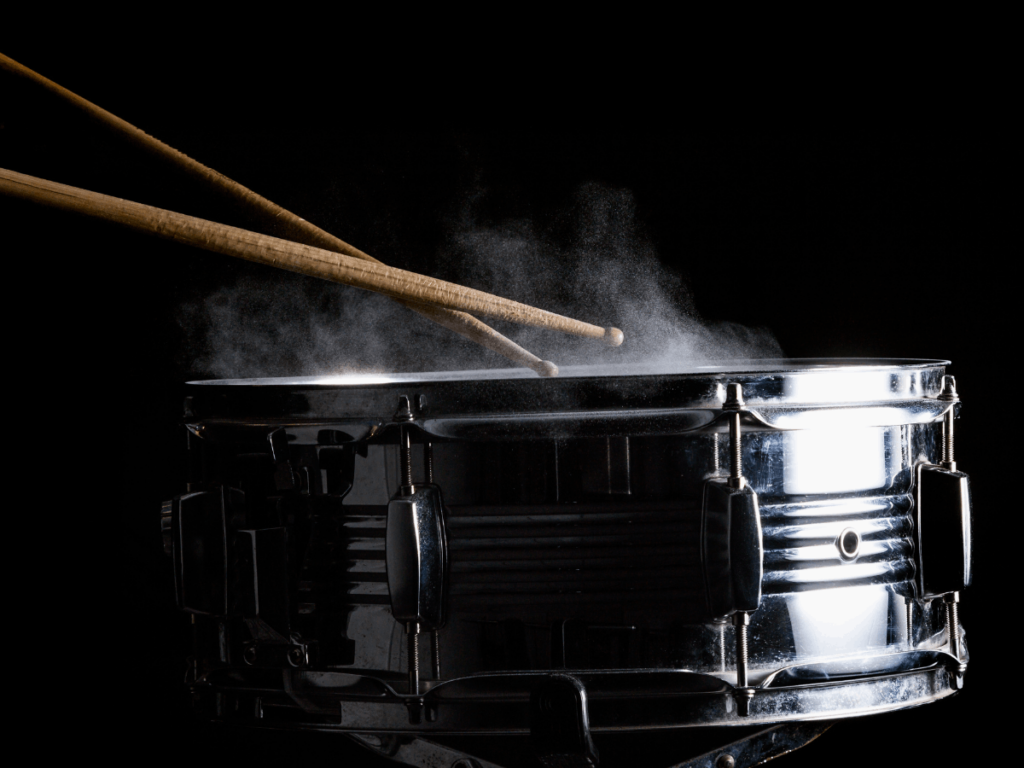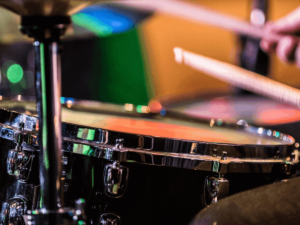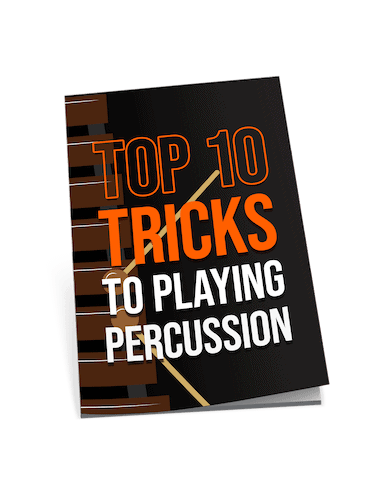Best
Snare Drum
-
Overall: High-quality
sound with a wide tuning range -
Best Feature: Seamless aluminium shell with stunning chrome plating
-
TedScore™: 9/10
Best
Bass Drum
-
Overall: Good value for the price, with high-quality construction and sound
-
Best Feature: Versatile 20" x 16" dimensions - fusion size for a variety of genres
-
TedScore™: 9.5/10
Best
Timpani
-
Overall: Lightweight and rugged fibreglass bowls with high-quality Remo heads
-
Best Feature: Also includes protective covers and pairs of Timpani mallets
-
TedScore™: 9/10
Feeling ready to add some zing to your musical treasure trove? Percussion instruments in the orchestra are the secret jewels bringing rhythm, texture, and colour to classical melodies.
These instruments create a unique musical tapestry that will blow your mind, from the thundering timpani to the delicate chimes.
Each instrument has its unique sound and playing technique, and when combined, they create a rich and complex musical experience.
In this article, we’ll explore the history and role of percussion instruments in the orchestra. We’ll dive into the different types of percussion instruments, their characteristics, and their unique sounds.
So, sit back, relax, and let’s go through the fascinating world of orchestral percussion together!
The Role and Importance of Percussion in the Orchestra

When you think of an orchestra, the first thing that comes to mind may not be the percussion section.
However, percussion instruments are crucial in creating an orchestra’s unique sound and rhythm.
The percussion section of an orchestra typically includes instruments such as the timpani, snare drum, bass drum, cymbals, triangle, xylophone, marimba, and more. These instruments provide rhythm, texture, and colour to the music.
The percussion section is usually positioned behind the other musicians at the back of the orchestra. This is because percussion instruments’ sound can be loud and overpowering, so it needs to be balanced with the other instruments in the orchestra.
The percussion section is led by a principal percussionist, who coordinates the section and works closely with the conductor to ensure that the percussion instruments are played at the right time and in the right way.
One of the most critical roles of percussion in the orchestra is to provide a steady beat and rhythm.
The percussion section is responsible for maintaining a consistent tempo throughout a piece of music, which helps to keep the other musicians in time.
On top of providing rhythm, percussion instruments can also create unique sounds and textures.
For example, the timpani can create a deep, resonant sound, while the snare drum can provide a sharp, staccato sound.
What Are Tuned and Untuned Percussion Instruments?

The orchestra has two main types of percussion instruments: tuned percussion instruments and untuned percussion instruments.
Tuned percussion instruments are those that produce specific notes and pitches.
Tuned percussion instruments include the xylophone, marimba, glockenspiel, and piano. These instruments are typically used to play melodies and harmonies in the orchestra.
On the other hand, untuned percussion instruments, as the name suggests, do not produce specific notes or pitches.
They include instruments such as the drum, bass drum, snare drum, cymbals, tambourine, gong, and bongos. These instruments create rhythm, texture, and accents in the orchestra.
The Snare Drum

The snare drum, also known as the side drum, is a percussion instrument that’s an essential part of the modern orchestra.
It consists of a cylindrical shell made of wood or metal with drumheads on both ends. The top head, the batter head, is struck with wooden sticks or a metal beater to produce a sharp, cracking sound.
The bottom head, known as the snare head, has a set of wires or gut strings called snares stretched across it, which vibrate when the drum is hit, producing a distinctive snare sound.
Role of the Snare Drum in the Orchestra
The snare drum is versatile in various musical genres, including classical music, jazz, and rock.
In the orchestra, the snare drum is an integral part of the percussion section and is usually played by a percussionist. Its primary role is to provide rhythm and accentuate the music’s dynamics, emphasising particular passages and creating a sense of tension or release.

In classical music, the snare drum is often used to create military or marching band effects and add colour and texture to the music.
It’s commonly used in symphonies, overtures, and operas, where it can create a sense of drama or urgency.
In jazz and popular music, the snare drum is an essential part of the drum kit and provides a backbeat, a steady pulse that underpins the music’s rhythm.
The Bass Drum

The bass drum is a large percussion instrument that produces a deep and booming sound. It’s a type of drum that is typically cylindrical and has a diameter of around 28 inches.
The bass drum is played with a foot pedal attached to a beater, which strikes the drum head. The head is made of either animal skin or synthetic material.
The bass drum has a long history in the orchestra. It has been used in orchestral music since the 18th century and is an essential component of the percussion section.
Aside from the bass drums, the concert bass drum typically played with mallets, is also commonly used in orchestras and other classical music ensembles.
They’re used to create a deep, resonant sound that adds to the overall texture and impact of the music.
Role of the Bass Drum in the Orchestra
The bass drum plays a crucial role in the orchestra. It’s used to provide a strong and steady beat, which helps to keep the rhythm of the music.
The bass drum is often used with other percussion instruments, such as snare and cymbals, to create a full and rich sound.

Aside from providing a solid beat, the bass drum also creates dramatic effects in the music. It can be hit with varying degrees of force to produce different levels of volume and intensity.
The bass drum is often used to mark important moments in the music, such as the beginning or end of a section.
The Timpani
Description of the Timpani and Its History

The timpani, also known as kettledrums, are percussion instruments used in orchestras for centuries.
They consist of large copper or fibreglass bowls with a drumhead of animal skin or synthetic material stretched over the top. A stand holds the bowl up, and the drumhead is tightened or loosened by a foot pedal or hand-operated screw mechanism.
The timpani was first used in European orchestras during the Baroque period, around the 17th century.
They were primarily used to provide rhythm and a deep, resonant sound to the music. Over time, composers began to write more complex and intricate parts for the timpani, and they became an integral part of the percussion section in orchestras.
Role of the Timpani in the Orchestra
The timpani plays a crucial role in the orchestra, providing both rhythm and melody to the music.
They’re often used to mark a piece’s beginning or end and accentuate important moments in the music. The timpani can produce many sounds, from deep, thunderous booms to high-pitched, ringing tones.
The timpanist, or kettledrum player, uses mallets to strike the drumhead and produce different sounds. The mallets can be made of various materials, such as wood, felt, or plastic, and can be shaped differently to produce different tones.
The timpanist must be skilled in controlling the volume and tone of the timpani, as well as in playing in time with the rest of the orchestra.

In modern times, some timpani have been equipped with valves or pedals that allow the player to change the drum’s pitch without manually adjusting the drumhead’s tension.
This has expanded the range of sounds that can be produced by the timpani and has made them even more versatile in the orchestra.
Cymbals and Other Percussion Accessories
Cymbals
They're made of thin, circular plates of brass or bronze that are struck together to produce a loud, crashing sound. Cymbals come in various sizes, from small finger cymbals to large crash cymbals up to 24 inches in diameter.
In the orchestra, cymbals add accents, create crescendos and decrescendos, and provide a dramatic effect to the music.
Triangle
In the orchestra, the triangle adds accents, creates a sense of sparkle or magic, and provides a delicate texture to the music.
Tambourine
In the orchestra, the tambourine adds rhythm, texture, and accents and is often used in dance music or music with folk or exotic flair.
Castanets
They're typically used to create a lively and festive atmosphere and are often associated with Spanish or Latin American music.
In the orchestra, castanets are used to add accents, create a sense of excitement, and provide a percussive texture to the music.
Jingles
They're typically used to add a bright and festive quality to the music and are often used in dance music or music with folk or exotic flair.
Jingles add rhythm, texture, and accents to the orchestra and are often played with other percussion instruments.
Mallet Percussion Instruments
Mallet percussion instruments are a group of melodic and harmonic instruments played by striking wooden or metal bars with mallets.
The bars are arranged like a piano keyboard and produce contrasting sounds that add depth and texture to the orchestra’s percussion section.
Some of the most commonly used mallet percussion instruments in the orchestra include the xylophone, marimba, vibraphone, glockenspiel, bells, chimes, and celesta.
Each instrument has its unique sound and is played with different types of mallets, hammers, and other accessories.
Each instrument has its unique sound and is played with different types of mallets, hammers, and other accessories.

The xylophone is one of the most prominent members of the mallet percussion family due to its bright, wooden sound. It comprises wooden bars supported by resonators and played with hard rubber mallets.
Conversely, the marimba has a deeper, more mellow sound and is played with yarn mallets. It has wooden bars that are wider and longer than the xylophone and are supported by resonators.
The vibraphone is a metal instrument with rotating disks inside its resonators, producing a vibrato effect when the bars are struck.
The glockenspiel is a smaller version of the xylophone with metal bars instead of wooden bars. The bells and chimes are also metal, producing a bright, shimmering sound.
The celesta, meanwhile, is a keyboard instrument that produces a soft, bell-like tone.
Role of These Instruments in the Orchestra

Mallet percussion instruments play an essential role in the orchestra by adding melodic and harmonic texture to the percussion section.
They’re often used to highlight specific themes or motifs in a piece of music and can create a wide range of emotions, from excitement and energy to tranquillity and serenity.
Composers often use mallet percussion instruments to create contrast and balance. They may pair the bright, metallic sound of the glockenspiel with the deep, mellow sound of the marimba, for example, to create a dynamic and exciting sound.
Moreover, mallet percussion instruments are often used in solo and ensemble performances, showcasing the musicians’ skill and artistry.
3 Best Percussion Instruments

FEATURES: Bright, crisp tone with unparalleled sensitivity for any scenario
OTHER INFO: Seamless aluminium shell with stunning chrome plating looks timeless
Ludwig LM400 14" x 5" Supraphonic Snare Drum, Imperial Lugs
When you check the price above, you’ll see there are loads of great places to buy this item. Our personal favorite is Gear4music.
It is the largest music retailer in the UK and fast becoming the most respected online music shop in the US too. Their customer service is excellent, they have competitive prices, really fast shipping, and usually have the longest guarantee.
Most professional musicians use Gear4music, so there is no reason why you shouldn’t too!
- High-quality sound with a wide tuning range
- Durable construction and classic design
- Higher price point compared to other beginner or intermediate snare drums
- Relatively heavier than other brands
The professional musician who wrote this article combined many things,
from the product build, manufacturer’s reputation through to feedback
from other users, to create our famous TedScore™.

FEATURES: Poplar and Asian Mahogany shell offers a balance of clean, crisp, and warm tones
OTHER INFO: A sleek Jet Black finish provides an understated look
Pearl EXX Export 20" x 16" Bass Drum, Jet Black
When you check the price above, you’ll see there are loads of great places to buy this item. Our personal favorite is Gear4music.
It is the largest music retailer in the UK and fast becoming the most respected online music shop in the US too. Their customer service is excellent, they have competitive prices, really fast shipping, and usually have the longest guarantee.
Most professional musicians use Gear4music, so there is no reason why you shouldn’t too!
- Good value for the price, with high-quality construction and sound
- Versatile instrument
- Limited colour options compared to other bass drums on the market
The professional musician who wrote this article combined many things,
from the product build, manufacturer’s reputation through to feedback
from other users, to create our famous TedScore™.

COMES WITH: Premium bundle containing 23", 26", 29" and 32" Orchestral Timpani
FEATURES: Lightweight and rugged fibreglass bowls
WHD COMPLETE TIMPANI DRUM SET
When you check the price above, you’ll see there are loads of great places to buy this item. Our personal favorite is Gear4music.
It is the largest music retailer in the UK and fast becoming the most respected online music shop in the US too. Their customer service is excellent, they have competitive prices, really fast shipping, and usually have the longest guarantee.
Most professional musicians use Gear4music, so there is no reason why you shouldn’t too!
- Provide a cost-effective alternative to copper bowled timpani without compromising on quality
- Also includes protective covers and pairs of Timpani mallets
- Mallets not included
The professional musician who wrote this article combined many things,
from the product build, manufacturer’s reputation through to feedback
from other users, to create our famous TedScore™.
Percussion Instruments In The Orchestra
Summary
The percussion family is the largest group, including any instrument that makes a sound when hit.
You’ll play many instruments as a percussionist, from the thundering bass drum to the twinkling triangle. Each instrument has its unique sound and role in creating the perfect beat for the orchestra.
Percussion instruments are like the heartbeat of music. They keep the rhythm and add depth and character to the sound. They’re the secret ingredient that makes music so enjoyable to listen to!
So, get ready to march to the beat of your drum and join the percussion family. With your skills, you’ll help create beautiful music that can move and inspire people!
Before you go…
If you want to explore more in the world of percussion instruments, electronic drum kits are a great place to start! You can check them out here: Top 14 Electronic Drum Kits for Beginners
With a wide range of features and affordable prices, these kits offer a fun and accessible way to learn about rhythm and drumming!
FAQ's
The percussion instruments in the orchestra include the snare drum, bass drum, timpani, cymbals, and various other percussion accessories, such as triangles, tambourines, and castanets.
Mallet percussion instruments, such as the xylophone, marimba, and vibraphone, are often included in the percussion section.
The number of percussion instruments in the orchestra can vary depending on the composition and arrangement. An orchestra typically has several percussion instruments, including the snare drum, bass drum, timpani, cymbals, and various other percussion accessories.
The percussion instruments in the orchestra are typically situated at the back of the stage, behind the string, woodwind, and brass sections. This allows the percussionists to be heard clearly and prevents their sound from overpowering the other sections.
The four main instrument families in the orchestra are the strings, woodwinds, brass, and percussion. Each family has its unique sound and characteristics that contribute to the overall sound of the orchestra.












i always thought cymbals were just for crashing together lol didn’t know there was so much technique behind it
Not sure I agree with the classification of the timpani strictly as percussion, shouldn’t it be considered more melodic given its tuning capability? Surely, the distinction between tuned and untuned isn’t just black and white. Curious to hear others’ thoughts.
While the distinction between tuned and untuned percussion instruments is clear, I wonder if the article could elaborate on methods for teaching beginners how to appreciate and understand these differences. Also, could specific techniques for mastering these instruments be touched upon? It would greatly benefit educators.
For teaching, starting with simple rhythm patterns on untuned instruments and gradually introducing tuned ones for melodic understanding works well. It transitions smoothly from rhythm to melody.
Would love to see those techniques too! Struggling with teaching the tuned percussions here.
Loved diving into the details about the snare drum’s role in the orchestra. It’s fascinating to see how each piece fits into the bigger picture. Props to Dave for crafting such an informative piece!